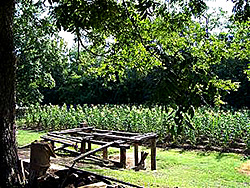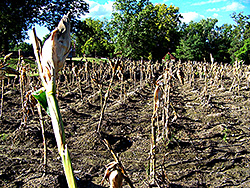Page content
Historic Farming
Corn
Indian corn, or maize, was the most widely consumed grain in 18th-century Virginia. As the basic ingredient for bread, hominy, grits, mush and porridge, corn constituted a significant portion of the average person’s diet. It was a fundamental food ration for field slaves. The blades and tops of the plant were fed to livestock during the winter months.
Of the several varieties grown in Virginia, “gourdseed” corn was the most productive and therefore the most popular. The stalk of a gourdseed plant was expected to reach a height of 10 to 18 feet and produce two to three ears that were seven or eight inches long. Known as “white dent,” or “she-corn,” gourdseed kernels were deep, broad and white with little or no variance in color. Their ends appear shriveled, or dented, when fully dried.
While corn was more difficult to cultivate than wheat, one farm laborer could produce five to 10 acres of it by hand, or 20 with a horse and plow. Corn was less troublesome to harvest than wheat, and it did not require threshing or treading before it could be ground. It also produced more grain per acre than wheat, and ears could be preserved for longer periods of time. Like other cereal grains, corn was usually cultivated on land that had been previously devoted to tobacco.
The early European settlers of the colony learned how to raise corn through the observation of native practices. Other than a later addition of the European plow in ground preparation, Virginia colonists strayed little from those methods. As early as February or March, farmers plowed several furrows across their fields at right angles to each other, creating a checkerboard-like pattern. The distances between intersections depended on the variety of corn that was to be grown and the quality of the soil. For large varieties, like gourd seed, distances ranged from four to eight feet, with six feet being the most common. Many farmers hilled the earth before planting it, others planted first and hilled later, around the base of their corn stalks.
Either way, the planting was done in April; three to six kernels were inserted “2 or 3 fingers’-breadth deep” in each hill. That depth helped protect them from birds, squirrels and other pests. Germination soon followed, and the plants were thinned to ensure sufficient room for growth. Each hill would carry two or four plants through the summer. In May, when the corn was about six inches tall, the field was hoed or plowed for weeds. Weeding and hilling continued until late June or early July, when the corn could be “laid by.” It no longer needed protection from weeds.
During its life cycle, the corn plants produce tassels at their tops, which drop pollen to the ear “silk” which leads directly to one kernel. After this fertilization, the ears grow large and full throughout the summer. In the 18th century, some ears may have been roasted and eaten at this stage, but most were not harvested until later, when their kernels were dry enough for preservation and later grinding into meal. When the tassels and tops of the plant were no longer of use and had begun to dry, they were cut off above the highest ear and bundled into sheaves of about a pound each. The tops were then left to cure in the sun for a day or two, before being taken away as cured fodder. The blades were pulled from the stalk a bit later, and they, too, were bundled and left to cure awhile before being stacked for animal consumption. Usually, fodder was saved until needed during the winter months, when sustenance for cattle and horses became scarce.
The ears of the corn plant were left upon its naked stalk until hard enough to store. Yields were about 15 bushels per acre or about 2,700 hills. Sometimes, the ears remained in the field past the first frosts of autumn before they were removed and stored, husk intact, in a cornhouse. A cornhouse was generally made of saplings, slats, or notched logs, with a floor a few feet off the ground and plenty of cross-ventilation. The one at Great Hopes Plantation can theoretically hold 86 barrels of cob corn, representing a little more than 14 acres of production. The ears of corn, if kept dry, preserve well in the husk, but some farmers “husked” the corn by night while picking it by day. Often, the job of husking continued into the winter months. The remaining corn stalks were of little use, but could be employed to stabilize muddy sections of pastures, or as fill material elsewhere.
To prepare the corn for grinding, the kernels must be removed from the cob. Two barrels of corn “on the cob” equal one barrel of shelled corn. Shelling the corn could be done by hand, but the most efficient way to do it was over a tub that had an iron scraper attached. Plantation masters allowed three barrels (15 bushels) of shelled corn annually for each adult slave that worked in their fields. Although usually reckoned in hills, 15 bushels to the acre would have been a typical yield.
Relatively easy to grow and abundantly productive, corn played a central role in supporting the colony from its earliest days of settlement as a source of food for both people and their animals. Corn was usually worth half as much as wheat. It became an export commodity by the last half of the 18th century. In 1772, Virginia shipped half a million bushels of Indian corn to other colonies along the coast and to the Caribbean, where it was needed for the maintenance of field labor.


